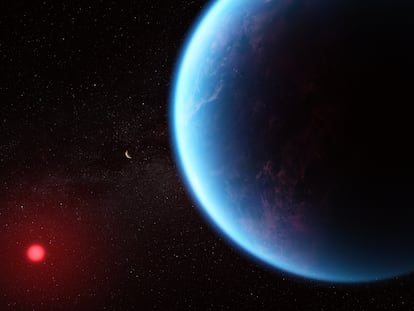The astronomer leading the search for a second planet Earth
Veteran discoverer of exoplanets Ignasi Ribas has received a European grant to multiply by 10 the capacity to discover planets like ours and determine if they contain life

A few numbers are enough to express how alone we humans seem to be in the universe. According to conservative estimates, in our Milky Way galaxy alone, there are 300 million planets similar to ours on which there could be liquid water and, therefore, the potential for life. Since 1995, we earthlings have built increasingly powerful telescopes that have allowed us to discover an astonishing 5,602 exoplanets beyond our solar system. Among all of those, only a few dozen have the right size, mass, and rocky composition, and even fewer orbit stars like our Sun. The number of truly Earth-like or Earth-identical planets identified so far is even more disappointing: zero.
Finding a twin planet to Earth would be a death knell to the narrative of many religions, including Christianity, and would prove that we are neither unique nor special in the cosmos. But making such a find is a devilish task. In our galaxy there are about 20 billion G-type stars, like the Sun. We would have to observe them all for an entire year to detect the orbiting Earths; and at least another year to confirm them. In addition to this daunting challenge, today’s most powerful telescopes, including the James Webb, are at their limits when it comes to viewing these worlds.
“If we analyze the very spectacular results from Webb since its launch and look at those that have come from more or less small planets with more or less faint signals, most of them — almost 100% — are inconclusive,” says Ignasi Ribas, director of the Institute of Space Studies of Catalonia and a researcher at Spain’s National Research Council, via videoconference. “Researchers see signals that may be the atmosphere of a terrestrial planet or due to stellar activity, but they do not know how to distinguish them. And this is the problem,” he explains.
Ribas is one of the Spain’s most veteran discoverers of exoplanets, with more than 70 new worlds to his name. Now he has just been awarded a prestigious grant of €2.5 million ($2.66 million) from the European Research Council to reverse this situation and multiply by 10 the observing capacity of current telescopes.
The issue is not detection technology, which has progressively improved, but stellar activity. Stars like the Sun are changeable. They have spots that move across their surface. They also have faculae, or regions that are brighter than the rest of the star. This variability produces signals that make it difficult or impossible to distinguish the light reflecting off a planet from that coming directly from its star. This “noise” hinders the direct observation of the planet as it passes in front of its star — known as transit — as well as the study of the small oscillations produced by the gravitational influx of a planet orbiting its star, known as radial velocity. The resolution of both techniques has been stalled for about a decade, Ribas explains.

“I’ll bet my little finger that we’ve already discovered stars that have earths and we’re not seeing them because it’s tremendously difficult to clean up all the noise in the signal,” he says. “The atmospheres of cool stars are rich in water vapor. If you see these signals, you might not be able to tell if it’s water in the planet’s atmosphere or in the star itself. The aim of this project is to overcome the barrier imposed by stellar activity. We want to provide the tools to reach an instrumental precision 10 times greater than what we currently have.”
Ribas’ project is called Spotless and will last for five years. It consists of creating digital simulations of the most interesting stars, with all their spots and faculae. The team would observe the star for a few months before, for example, the transit of a possible Earth-like planet. “Because we will have a superfine star model, we will be able to do millions of simulations and tell an artificial intelligence machine learning algorithm: here are the variation possibilities of such a star and here are some observations. Tell me which part of the variations of these observations are attributable to the activity of the star, and which others are the presence of a planet,” says Ribas.
The astrophysicist explains that his team has been performing this work in a more or less organized way for about a decade. The new funding will make it possible to hire eight researchers to join the four already involved in the project and to carry it out more systematically. The first step will be to validate a new star model using the Sun as a reference. After that, other models of nearby solar stars will be built. “At the beginning we will stretch the gum a little with planets a bit larger or smaller than the Earth in stars that may also be approximately like the Sun, but in the end, we will be able to look for worlds very similar or identical to ours,” says Ribas.
The project will focus on data collected by Espresso, an instrument attached to the Very Large Telescope in Chile, which searches for planets using radial velocity, as well as infrared light data from the James Webb Telescope. In 2026, the European Space Agency will launch the Plato telescope, specially designed to search for terrestrial planets in hundreds of stars like the Sun, which will add a new data bank to apply the models created by Ribas’ team.
Ribas believes that the first “exo-Earths” will almost certainly be discovered in around five years. But the danger of falling just short of the biggest find imaginable remains. “If we’re lucky enough that the new planet is on a tremendous star fairly close to our planet, it will be easy to use the James Webb to characterize its atmosphere and look for water vapor. But if it’s a fainter, more distant star, we may not have sufficient resolution.”
Sign up for our weekly newsletter to get more English-language news coverage from EL PAÍS USA Edition









































